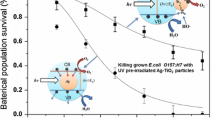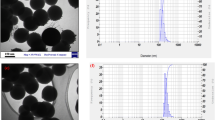Abstract
The silica nanoparticles were prepared by the sol–gel process, and then twice modified and grafted by polyethylenimine (PEI) on their surface. After quaternary ammonium reaction and chelated copper reaction, the PEI/SiO2, QPEI/SiO2, PEI–QPEI/SiO2 and Cu (II)/PEI–QPEI/SiO2 nanopowders were obtained in turn. The morphology and structure of the products were characterized through SEM, EDX, HRTEM, FTIR and element analysis. At the same time, the antibacterial activity of the products to E. coli and Candida were evaluated through quantification and qualitative ways, e.g. microcalorimetric method and culture dish method. The results suggested that the Cu (II)/PEI–QPEI/SiO2, a novel three-component functional nanopowder, presented the best antibacterial activity to both E. coli and Candida duo to the synergistic sterilization capability of the ammonium salt and copper ions, compared with other products. It indicated that the Cu (II)/PEI–QPEI/SiO2 nanopowder could be a novel antibacterial nanomaterial to widely application in preventing and minimizing bacteria of the organism and environment in future.











Similar content being viewed by others
References
Rastogi SK, Rutledge VJ, Gibson C (2011) Ag colloids and Ag clusters over EDAPTMS-coated silica nanoparticles: synthesis, characterization, and antibacterial activity against Escherichia coli, nanomedicine: nanatechnol. Biol Med 7:305–314
Imazato S, Ebi N, Takahashi Y (2003) Antibacterial activity of bactericide-immobilized filler for resin-based restoratives. Biomaterials 24:3605–3609
Kenawy ER, Worley SD, Broughton R (2007) The chemistry and applications of antimicrobial polymers: a state-of-the-art review. Biomacromolecules 8:1359–1384
Lenoir S, Pagnoulle C, Galleni M, Compere P, Jerome R, Detrembleur C (2006) Polyolefin matrixes with permanent antibacterial activity: preparation, antibacterial activity, and action mode of the active species. Biomacromolecules 7:2291–2296
Yuan W, Wei J, Lu H, Fan L, Du J (2012) Water-dispersible and biodegradable polymer micelles with good antibacterial efficacy. Chem Commun 48:6857–6859
Kim HW, Kim BR, Rhee YH (2010) Imparting durable antimicrobial properties to cotton fabrics using alginate–quaternary ammonium complex nanoparticles. Carbohydr Polym 79:1057–1062
Jang J, Kim Y (2008) Fabrication of monodisperse silica–polymer core–shell nanoparticles with excellent antimicrobial efficacy. Chem Commun 34:4016–4018
Hough-Troutman WL, Smiglak M, Griffin S (2009) Ionic liquids with dual biological function: sweet and anti-microbial, hydrophobic quaternary ammonium-based salts. New J Chem 33:26–33
Ortega P, Patino JLC, Fernandez AM (2008) Amine and ammonium functionalization of chloromethylsilane-ended dendrimers. Antimicrobial activity studies. Org Biomol Chem 6:3264–3269
Song J, Kong H, Jang J (2011) Bacterial adhesion inhibition of the quaternary ammonium functionalized silica nanoparticles. Colloids Surf B 82:651–656
Paul DR, Robeson LM (2008) Polymer nanotechnology: nanocomposites. Polym 49:3187–3204
Sun X, Cao Z, Porteous N, Sun Y (2010) Amine, melamine, and amide N-halamines as antimicrobial additives for polymers. Ind Eng Chem Res 49:11206–11213
Bouloussa O, Rondelez F, Semetey V (2008) A new, simple approach to confer permanent antimicrobial properties to hydroxylated surfaces by surface functionalization. Chem Commun 28:951–953
Qiu J, Zhang Y, Zhang Y (2011) Synthesis and antibacterial activity of copper-immobilized membrane comprising grafted poly (4-vinylpyridine) chains. J Colloid Interface Sci 354:152–159
Xu J, Feng X, Chen P, Gao C (2012) Development of an antibacterial copper (II)-chelated polyacrylonitrile ultrafiltration membrane. J Membr Sci 413–414:62–69
Mekahlia S, Bouzid B (2009) Chitosan-Copper (II) complex as antibacterial agent: synthesis, characterization and coordinating bond-activity correlation study. Phys Procedia 2:1045–1053
Chen Y, Zhang Y, Liu J (2012) Preparation and antibacterial property of polyethersulfone ultrafiltration hybrid membrane containing halloysite nanotubes loaded with copper ions. Chem Eng J 210:298–308
Harrison JJ, Turner RJ, Joo DA (2008) Copper and quaternary ammonium cations exert synergistic bactericidal and antibiofilm activity against pseudomonas aeruginosa. Antimicrob Agents Chemother 52:2870–2881
Chen S, Guo Y, Chen S (2012) Facile preparation and synergistic antibacterial effect of three-component Cu/TiO2/CS nanoparticles. J Mater Chem 22:9092–9099
Jing ZH, Wang CC, Wang GL, Li WJ, Lu DM (2010) Preparation and antibacterial activities of undoped and palladium doped titania nanoparticles. J Sol–Gel Sci Technol 56:121–127
Wadsö I (1995) Microcalorimetric techniques for characterization of living cellular systems. Will there be any important practical applications? Thermochim Acta 269–270:337–350
Gao B, An F, Liu K (2006) Studies on chelating adsorption properties of novel composite material polyethyleneimine/silica gel for heavy-metal ions. Appl Surf Sci 253:1946–1952
Gao B, Zhang X, Sheng Y (2008) Studies on preparing and corrosion inhibition behaviour of quaternized polyethyleneimine for low carbon steel in sulfuric acid. Mater Chem Phys 108:375–381
Acknowledgments
The work was financially supported by National Nature Science Foundation of China (No. 21271115), and the Laboratory Open Fund of Qufu Normal University (No. 2013SK004).
Author information
Authors and Affiliations
Corresponding author
Rights and permissions
About this article
Cite this article
Huang, Y., Ma, S. & Jing, Z. Preparation of Cu (II)/PEI–QPEI/SiO2 nanopowder as antibacterial material. J Sol-Gel Sci Technol 72, 351–358 (2014). https://doi.org/10.1007/s10971-014-3439-9
Received:
Accepted:
Published:
Issue Date:
DOI: https://doi.org/10.1007/s10971-014-3439-9




